
Dances and Irish tap-dancing
"The love of dance appears to be inherent in the Irish and constitutes one of their essential national character traits.”
Francis O'Neill (1913)
Introduction
The dances that we still see today in Ireland appeared, for the most part, from the 17th century onwards, i.e. the figure dances (where people dance in a line, or a circle). They are therefore always group dances, as opposed to solo dances (or step dances), which probably appeared later in the 18th century. We later find these step dances in the 20th century, in Riverdance (1994) which we shall look at more closely in this thematic study.
However, we know very little about dance in Ireland during the Antiquity and the Middle Ages: the first references date only back to the 14th century, and the Gaelic language didn’t even have a word to describe this activity before the 16th century: the two terms currently used are rince, borrowed from English, and damhsa, borrowed from French.
The oldest iconographic representation dates back to 1620, where a leader of a Gaelic clan and four of his men engaged in a sword dance can be seen on the cover of a book, now conserved at the National Museum in Dublin.
The role of the dance masters
Modern Irish dances, which emerged in the 17th century, were originally common to the British Isles, Germany, France, and Italy, etc., and references to such dances are very numerous in the 18th century in the stories of travellers - proof of its importance in all strata of society: "the art of dance was commonplace among the poor. The dance master crosses the country, moving from house to house, accompanied by a blind bagpipe or violin player" (Arthur Young, Tour of Ireland, 1776-79).
The travelling dance master described in this extract is a key figure in the southwest of Ireland (counties of Kerry and Cork) at the beginning of the 18th century: He was the main creator and spreader of dances, which he taught from village to village.
This craze for dancing throughout Europe originally came from the desire of wealthier populations to learn the dances of the aristocracy, for whom the dance masters had been deploying their art since at least the 15th century in Italy and France. Gradually, these dance masters began to offer their services to all segments of the population: in Ireland, their influence continued to be felt in some regions until the beginning of the 20th century
Their omnipresence in Irish life was in large part due to the efforts made by some of these entertainment professionals - who did not hesitate to go to Dublin, London, or Paris - to keep constantly abreast of new dances and to teach them in their designated area, which often was no more than a few square kilometres in some regions like Kerry, where they were particularly numerous.
In Ireland, it was not unusual for the dance master to assume the role of school teacher, and was often accompanied by a musician on his travels, unless he himself was a musician. He generally found accommodation in an inhabitant’s homes, who in exchange was not only able to enjoy the honour of such a noble and prestigious deed, but could also receive free lessons. In some instances, the inhabitants of a municipality took it in turns to provide accommodation. The payment of lessons was usually settled during a benefit night, held after a stay lasting between three and six weeks before the master left to teach his art somewhere else.
It was probably due to the influence of the Napoleonic wars (1800-1815) and the huge intermingling of populations in Europe at the time that the dance masters could introduce dances learned in Dublin throughout the country These dances had themselves originally come from England and the continent, but were adapted to be used with Irish melodies. One of the main innovations was the introduction of the quadrille, a figure dance for 4 couples, which arrived in Dublin in 1816 and which gradually spread to the Irish countryside.
Originally, these quadrilles did not only include figures but also very precise dance steps, albeit sufficiently simple to be danced by beginners, who were after all the dance masters main “students”. Sometimes, it is considered that the very essence of Irish dance culture in the 19th century is founded on the importance of knowing these steps and not on actually knowing the figures.
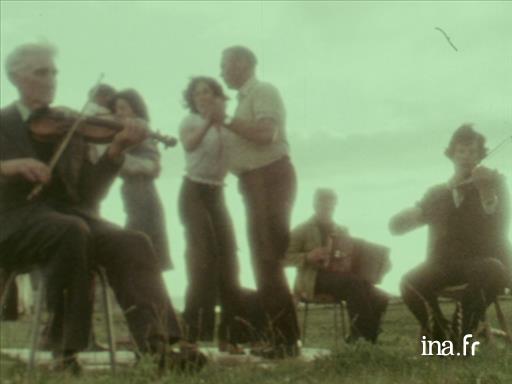
Gradually however these steps disappeared in Europe during the 19th century. Except of course in Ireland! As the dance masters continued to use this technique, and thus became the pinnacle of their art, adding increasing complex ornamentation to the dance steps they performed, and only taught to their most gifted students: each 'step' was made up of a set of foot and leg movements and jumps, with a total of 8 measures. The use of the word step in step-dance refers to this technique, now more commonly found in the region of Connemara, County Galway.
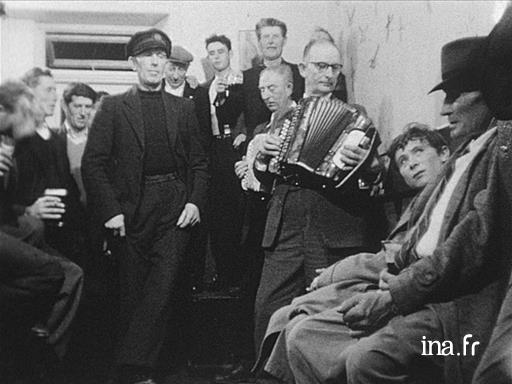
Fishermen of Ireland: The atmosphere in a pub in Clifden
In a pub in Clifden in County Galway, Ireland, traditional dance is performed by a fisherman. A man dances alone to the sound of an accordion, surrounded by hid fellow men, with a glass of beer in his hand. The footwork is fast, accenting the rhythm of the music while the rest of the body does not move and is perfectly straight.
These men - this travelling profession was considered too risky for women - even organised competitions with each other, giving them the opportunity to demonstrate their full prowess. Similarly, the best of them did not stop at teaching dance steps, but when the occasion arose, they because creators of new solo dance steps, which enhanced their notoriety each further. It is therefore understandable that these dances by definition became solo dances given the complexity of their steps and given each dancer’s own personal ornamentations.
Following the gradual disappearance of dance masters from the Irish landscape from the end of the 19th century, a large number of cultural associations were set up with a view to safeguarding the country’s cultural heritage: literature, the Gaelic language, sport, theatre and music all experienced an unprecedented revival from the 1880s onwards as a means to assert the Irish identity in all its forms.
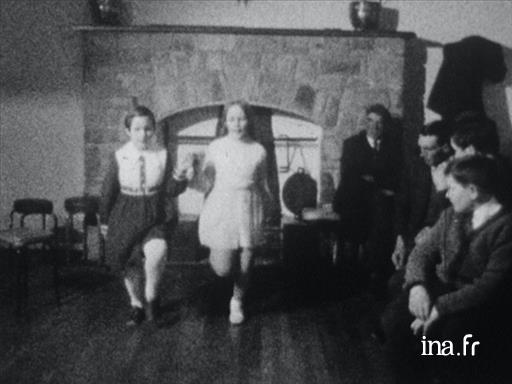
Traditional Irish dances
In part of a programme on the origins of American music, there are of course its Irish roots, especially when it comes to dance. In this sequence three types of traditional Irish dance are being performed to the sound of a musical group consisting of a piano, a violin and Irish percussion: We see the "Brush dance" or "Broom dance", a dance for two, which is fast and athletic, and a traditional dance performed by a very serious and focused young girl.
Certainly the most important of these associations, the Gaelic League, was founded in 1892, and its first dance evening took place in London in 1897: it was the first Irish Céilí!
It was also at this time that the Gaelic League started to organize dance competitions among its large cultural events, which actually stirred up a great deal controversy owing to its intolerance of dances from abroad, especially those from England. Despite this clearly excessive nationalism, and the irreparable cultural losses that were incurred due to such a uniformization of styles, these cultural associations should nevertheless be praised for the work they did to conserve Irish dances, which are still known today.
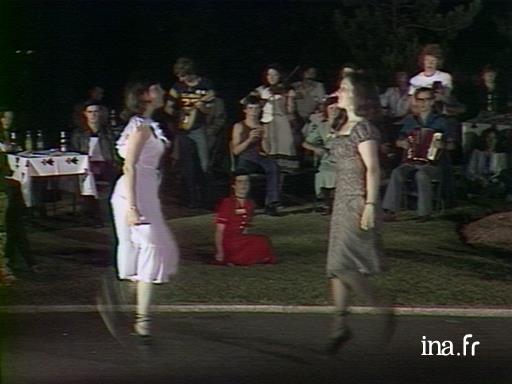
The Festival Interceltique de Lorient, - Irish traditional dance
Presentation of traditional Irish dancing performed in pairs at the Festival Interceltique de Lorient. The dances are performed wearing half-high heels with the legs extended outwards, to the sound of "Celtic" music, which is somewhat difficult to describe precisely.
The exporting of Irish dances
The other major factor that has helped ensure the preservation of Irish culture was, paradoxically, the mass emigration of the Irish from the 19th century onwards, especially towards Britain, the US, Canada and Australia.
Moreover, it is possible that the poverty of the majority of these emigrants, and a certain form of ostracism shown towards people from Catholic European countries (including Italy and Ireland), were factors in the creation of a fundamental dance phenomenon of the 20th century: tap dancing, or American tap. Indeed, we know that this dance form, which appeared in the middle of the 19th century in the USA, was born from the fusion of Irish step-dances and African percussive dances, before being performed on theatre stages in the 1920s.
There are currently two competing theories for its origin: the older theory explains that this artistic fusion probably occurred between black slaves and Irish servants on plantations in the historic South, while another more recent theory postulates that it happened in the north of the country, in the slums of Manhattan. Whatever its origin, it is undeniable that the leading American tap-dancing stars of the 1930s and 1940s including Shirley Temple, Fred Astaire and Ginger Rogers, owe much to both Irish step dancing and African tribal dances.
Other fusions to arise from the American melting pot became recipes for amazing styles of dance: clogging, the Native American dance alliance, Irish jigs, African percussion, which resulted in a discipline that was halfway between square dance and American tap.
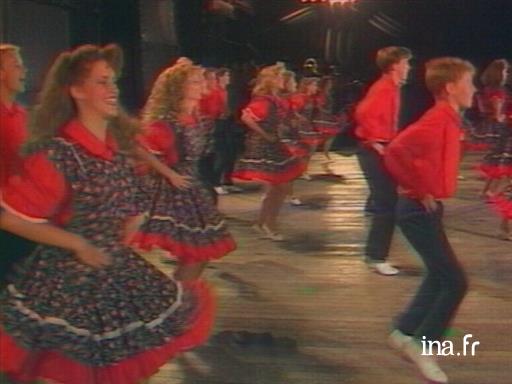
Folk dance in Confolens: American clogging
Broadcast of one of the performances of the festival of Confolens, dated 15th August, with Turkish, Yugoslavian, American and Palestinian folk groups. Between two dances, Christophe Chavanet takes us behind the scenes of the festival, speaking with a young American who performs a dance, originating from Irish culture: clogging.
In Ireland, the step dance was saved thanks to the Gaelic League and the establishment of the Irish Dancing Commission in 1929, which defined strict rules for the dance. During the 20th century, these sole dances took on a very feminine and very competitive allure, with over-ornate costumes, medals, wigs, fiberglass shoes, accessories, and rhinestones, etc.
From the late 1930s onwards, and under the influence of the Catholic Church, these dances saw a certain rigidity in terms of style, in large part due the obligation to keep the arms held closely to the body. Competitions largely removed the sensual, even sexual dimension of the dance, found to be inconsistent with the idealistic concept of Irish purity, defended by the most extremist of the nationalist activists.
But these step dances, which had been perfected by dance masters in the 19th century, and then transported by emigrants, made their comeback on the international stage at the Eurovision Song Contest on 30th April 1994, when a simple 7-minute performance named Riverdance changed the course of Irish history. Irish dance had finally found its freedom.
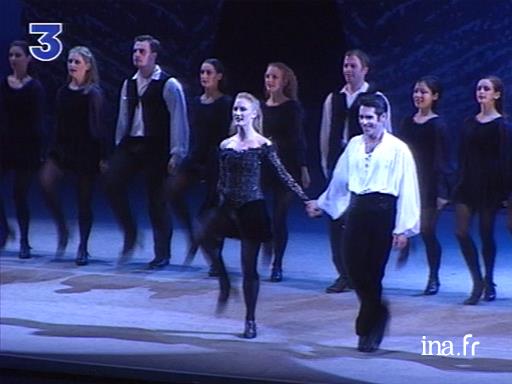
"Riverdance": as show for the whole world
Before the triumph of this choreographic and musical performance, it was quickly decided to develop the idea around the personalities of Michael Flatley (choreographer and main dancer), and John Butler (1st dancer), as well as the music arranged by Bill Whelan. The success of the performance Riverdance from 1995 onwards, not only in Ireland but also in the United States and the four corners of the word, was simply phenomenal. And, not surprisingly, much of the show was devoted to the coming together of Irish dancers and African American dancers.
Apart from a few purists, the critics were enthused. The main dancers, Michael Flatley and Jean Butler, both Americans from the Irish community, believed they were embodying Earth and water respectively for the performance. However, for the vast majority of the Irish, these two dancers first and foremost symbolized the new appeal of Irish dance and its new-founded drive. In addition to seeing a tendency towards much more sober, black, short, feminine costumes, Irish dance, which had now been stripped of its purely competitive purpose, could finally be described as '”sexy” by the Irish themselves.
In 1995, Michael Flatley decided however to leave the dance company (for financial reasons) and to create his own shows, *Lord of the Dance, Feet of Flame *, etc. Several dance troops based on the same model began to travel around the planet, offering different visions of Irish dance and in their wake incited the opening of thousands of Irish dance schools across the world.
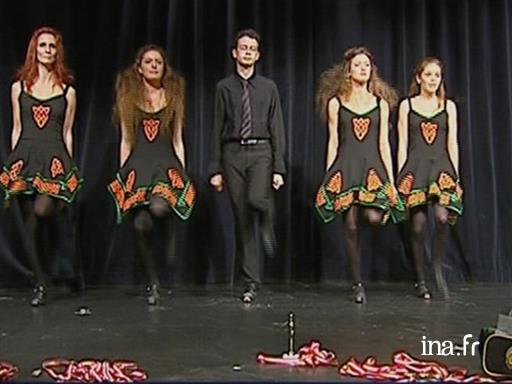
Caux Sport: Irish tap-dancing
For those of you who do not have the possibility of travelling to Ireland, you can still find a little local folk music in Pointe de Caux. A teacher instructs a hundred or so students in one of the Irish traditions par excellence: tap-dancing: a dancesport that requires hours and hours of training. Irish tap dancing is practiced without moving the arms or upper body. As with all dances, it should come naturally.
But was it genuine Irish dance and Irish music? Musically speaking, the arrangements of Bill Whelan based on Irish and Bulgarian themes were unfortunately judged for being what they were not or didn’t really claim to be: Irish traditional music. But the composer was in no way responsible for these misunderstandings, especially considering that the beats lent themselves perfectly to traditional Irish dancing (reels, jigs, hornpipe).
The choreography and the rendition of Riverdance, including the costumes, were also criticized as being too “Hollywood”. But many forget, whether it was a conscious decision by Bill Whelan or not, that these costumes were neither more nor less artificial than those that have been used in dance competitions since the beginning of the 20th century. Finally, other critics criticized the line formation of the dancers, despite the fact that this type of Irish dance is essentially a solo dance form. The energy of the moment was nonetheless undeniable, and the performance was simply gripping. A very large number of teenagers across the globe rushed to take classes of Irish dance- very much hitherto considered dormant- and now dance in Ireland, after having been ingrained into the Irish nationalist spirit of the beginning of the 20th century, was finally waking up, at the same time as the county’s economy!



